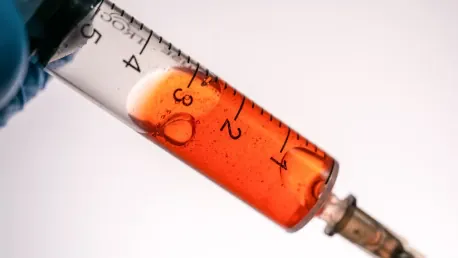A significant advancement in hepatitis B vaccination has emerged, especially beneficial for individuals living with HIV. According to research led by a Weill Cornell Medicine investigator, a newer hepatitis B vaccine known as HepB-CpG (trade name Heplisav-B) demonstrates substantially superior protection when compared to the traditional aluminum hydroxide adjuvant-based vaccine HepB-alum (trade name Engerix-B). This novel vaccine incorporates a cytosine phosphoguanine adjuvant, offering a more robust immune response.
Breakthrough in Hepatitis B Vaccination
Superior Protection with HepB-CpG
The study, published in the Journal of the American Medical Association (JAMA) on December 1, revealed that HepB-CpG induced protective antibody levels in up to 99.4% of participants who received the vaccine. In contrast, only 80.6% of those who were administered HepB-alum achieved similar protection levels. This finding is particularly significant as it paves an immunization pathway for many HIV-positive individuals who do not respond effectively to older hepatitis B vaccines.
Dr. Kristen Marks, the principal investigator and a corresponding author of the study, highlighted the vital importance of this discovery. Dr. Marks, an associate professor of medicine at Weill Cornell Medicine and an infectious disease specialist at NewYork-Presbyterian/Weill Cornell Medical Center, noted the critical need for effective vaccines in people with HIV. These individuals often have impaired immunity, limiting their ability to combat infections like hepatitis B or elicit a robust immune response after vaccination.
Hepatitis B Virus and Its Impact
Hepatitis B virus (HBV) is primarily transmitted through the exchange of body fluids during childbirth, sexual activity, and needle sharing, often among drug users. While it can lead to chronic infections that may initially present without symptoms, it frequently progresses to severe liver conditions such as cirrhosis and liver cancer. The World Health Organization estimated that over 250 million individuals worldwide were living with chronic hepatitis B infection in 2022, with more than a million deaths annually attributed to the virus. In the U.S., an estimated 5 to 10 percent of those infected with hepatitis B are also living with HIV.
In response to this challenge, the National Institutes of Health (NIH) sponsored the BEe-HIVe (B-Enhancement of HBV Vaccination in Persons Living With HIV) trial. This phase 3 study encompassed 561 participants across 40 sites in North and South America, Africa, and Asia. The participants, who previously had been vaccinated against hepatitis B but lacked sufficient antibody protection, were divided into groups receiving either the HepB-CpG or HepB-alum vaccine. Both vaccines contain identical quantities of a lab-synthesized hepatitis B virus protein, but their adjuvants—substances added to enhance the immune system’s response—differ.
The BEe-HIVe Trial
Study Design and Participants
To tackle the issue of inadequate antibody protection in individuals with HIV, the BEe-HIVe trial investigated the efficacy of the HepB-CpG vaccine compared to the traditional HepB-alum vaccine. This NIH-sponsored phase 3 study included a diverse group of 561 participants from North and South America, Africa, and Asia. These participants had previously received the hepatitis B vaccine but did not have adequate antibody protection.
Participants in the study were divided into groups that received either the HepB-CpG or HepB-alum vaccine. Both vaccines contained lab-synthesized hepatitis B virus protein in identical quantities. However, the adjuvants employed in each vaccine differed. Adjuvants are critical compounds added to vaccines to stimulate the immune system, and the different adjuvants used in these two vaccines were central to their differing efficacy.
Results and Implications
Findings from the BEe-HIVe trial indicated a marked preference for the HepB-CpG vaccine, particularly for HIV-positive individuals with insufficient antibody protection. HepB-CpG elicited a stronger antibody response compared to HepB-alum, and its effectiveness was reinforced by prior research showing high protection rates in patients with conditions such as diabetes and end-stage kidney disease. These patient groups, like individuals with HIV, tend to have poor responses to traditional hepatitis B vaccines.
During the trial, Dr. Marks and her colleagues observed a 100% protective antibody response rate in HIV-positive participants who had not previously been vaccinated against hepatitis B but received the HepB-CpG vaccine. This initial phase of the study reaffirmed the vaccine’s potential to induce robust immune responses, even in populations with compromised immune systems.
Detailed Findings and Future Directions
Cohort Analysis
The study’s design encompassed three distinct cohorts: one receiving three doses of HepB-CpG, another receiving three doses of HepB-alum, and a final group administered the standard two doses of HepB-CpG. Both HepB-CpG cohorts demonstrated superior performance compared to the HepB-alum group. The three-dose HepB-CpG group achieved an impressive 99.4% protection rate, the two-dose group reached a 93.1% protection rate, whereas the HepB-alum group attained an 80.6% protection rate. Importantly, no new safety concerns were noted during the trial, illustrating the favorable safety profile of the HepB-CpG vaccine.
Ongoing Research
A major breakthrough in hepatitis B vaccination has been made, proving especially advantageous for those living with HIV. New research helmed by a Weill Cornell Medicine scientist reveals that a newer hepatitis B vaccine, HepB-CpG (trade name Heplisav-B), offers significantly better protection than the older vaccine, HepB-alum (trade name Engerix-B), which uses an aluminum hydroxide adjuvant. The innovative HepB-CpG vaccine features a cytosine phosphoguanine (CpG) adjuvant, resulting in a much stronger immune response. This advancement is particularly crucial for immunocompromised individuals, such as those affected by HIV, who often struggle to gain effective immunity from traditional vaccines. With the introduction of Heplisav-B, these individuals can now achieve a higher rate of successful inoculation against hepatitis B, thereby reducing their risk of infection and associated complications. This development marks a significant step forward in public health, offering improved protection and hope for a better quality of life to many.









